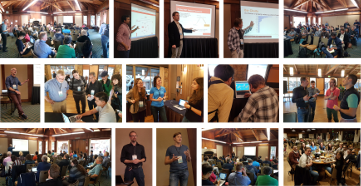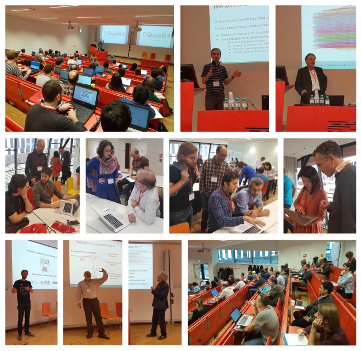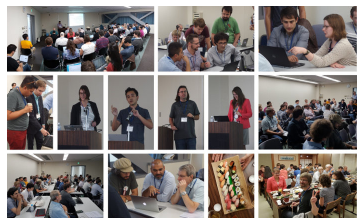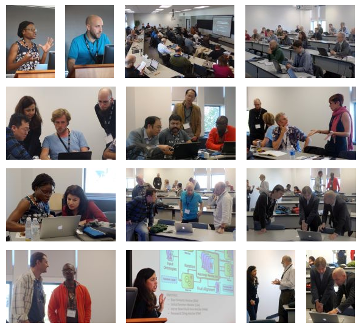Visualization and Interaction for Ontologies, Linked Data and Knowledge Graphs
9th International Workshop co-located with ISWC 2024, November 12th, 2024, Baltimore, USA

Motivation and Objectives
A picture is worth a thousand words, we often say, yet many areas are in demand of sophisticated visualization techniques, and the Semantic Web is not an exception. The size and complexity of semantic data—Ontologies, Linked Data and Knowledge Graphs—constantly grows and the diverse backgrounds of the users and application areas multiply at the same time. Providing users with visual representations and intuitive interaction techniques can significantly aid the exploration and understanding of the domains and knowledge represented by semantic data.
Visualizing Ontologies, Linked Data or Knowledge Graphs is not a new topic and a number of approaches have become available in recent years, with some being already well-established, particularly in the field of ontology modeling. In other areas of ontology engineering, such as ontology alignment and debugging, although several tools have been developed, few provide a graphical user interface, not to mention navigational aids or comprehensive visualization and interaction techniques.
In the presence of a huge network of interconnected resources, one of the challenges faced by the Semantic Web community is the visualization of multidimensional datasets to provide for efficient overview, exploration and querying tasks, to mention just a few. With the focus shifting from a Web of Documents to a Web of Data, changes in the interaction paradigms are in demand as well. Novel approaches also need to take into consideration the technological challenges and opportunities given by new interaction contexts, ranging from mobile, touch, and gesture interaction to visualizations on large displays, and encompassing highly responsive web applications.
There is no one-size-fits-all solution but different use cases demand different visualization and interaction techniques. Ultimately, providing better user interfaces, visual representations and interaction techniques will foster user engagement and likely lead to higher quality results in different applications employing semantics, and proliferate the consumption of Ontologies, Linked Data and Knowledge Graphs.
Proceedings
Workshop proceedings are published as CEUR Workshop Proceedings, vol. 3773, CEUR-WS.org, 2024.
Program
The workshop will take place on November 12th, 09:00 - 12:40 (Eastern Daylight Time), Room: To Add.
09:00 - 09:15 Opening and Introduction
Topic 1: Visualization and Exploration of Knowledge Graphs and Linked Data
09:15 - 09:40 The Knowledge Graph Explorer for the Virtual Record Treasury of Ireland
by Alex Randles, Lucy McKenna, Lynn Kilgallon, Beyza Yaman, Peter Crooks, Declan O'Sullivan
09:40 - 10:05 Customizable Knowledge Graph Visualization using the Whyis Knowledge Explorer
by Jamie P. McCusker
10:05 - 10:30 Vertical Context of Geographic Locations: An Empirical Comparison of Three Visualization Approaches
by Prasad Madushanka, Auriol Degbelo
10:30 - 11:00 Break
Topic 2: Evaluation of SW-based Tools/Interfaces
11:00 - 11:25 Evaluating InterDev: A FAIR Platform for International Development Data
by Matt Murtagh-White, P.J. Wall, Declan O'Sullivan
11:25 - 11:50 Evaluating the Knowledge Graph Editor of the Virtual Record Treasury of Ireland
by Alex Randles, Lucy McKenna, Lynn Kilgallon, Beyza Yaman, Peter Crooks, Declan O'Sullivan
Topic 3: Demo
11:50 - 12:15 KGSnap! in Practice: a Block-based Programming Environment for Enabling Knowledge Graph Literacy
by Alessia Antelmi, Vincenzo Offertucci, Maria Angela Pellegrino
12:15 - 12:30 Closing
Topics of Interest
Topics, subjects, and contexts of interest include (but are not limited to):
- Topics:
- visualizations
- user interfaces
- visual analytics
- requirements analysis
- case studies
- user evaluations
- cognitive aspects
- Subjects:
- ontologies
- linked data
- knowledge graphs
- ontology engineering
- Contexts:
- classical interaction contexts (desktop, keyboard, mouse, etc.)
- modern interaction contexts (mobile, touch, gesture, speech, etc.)
- special settings (large, high-resolution, and multiple displays, etc.)
- specific user groups and needs (people with disabilities, domain experts, etc.)
Submission Guidelines
Paper submission and reviewing for this workshop are organized via EasyChair. The papers should be written in English, following the CEUR-WS one-column template. Abstracts should be submitted by July 7, 2024 while the paper in PDF should be submitted by July 11, 2024.
All deadlines are midnight Anywhere on Earth time.
For details on the PDF submission format, see The New CEURART Style.
The following types of contributions are welcome. The recommended page length is given in brackets.
There is no strict page limit but the length of a paper should be commensurate with its contribution.
Note that according to the CEUR conditions, papers shorter than 10 pages will be marked as 'short papers'.
- Full research papers (8-12 pages);
- Experience papers (8-12 pages);
- Position papers (6-8 pages);
- Short research papers (4-6 pages);
- System papers (4-6 pages).
It is recommended to include a (persistent) URI to a working implementation or an (annotated) screencast for submissions presenting interactive visualizations, user interfaces, tools, etc.
Accepted papers will be published as a volume in the CEUR Workshop Proceedings series, as in previous years.
For details concerning the conference and/or workshop registration, please refer to the ISWC registration page.
Organizers
Patrick Lambrix, Linköping University, Sweden
Huanyu Li, Linköping University, Sweden
Susana Nunes, University of Lisbon, Portugal
Catia Pesquita, University of Lisbon, Portugal
Programme Committee
Ali Hasnain, Royal College of Surgeon, Ireland
Kārlis Čerāns, University of Latvia, Latvia
Anika Gross, Anhalt University of Applied Sciences, Germany
Mayank Kejriwal, University of Southern California, USA
Ying Li, Linköping University, Sweden
Declan O'Sullivan, Trinity College Dublin, Ireland
Evan Patton, Massachusetts Institute of Technology, USA
Emmanuel Pietriga, INRIA, France
Harald Sack, FIZ Karlsruhe, Leibniz Institute for Information Infrastructure & KIT Karlsruhe, Germany
Ahmet Soylu, OsloMet – Oslo Metropolitan University, Norway
Markel Vigo, The University of Manchester, UK
Sponsors
Important Dates
- Abstract:
July 7, 2024 - Submission:
July 11, 2024 - Notification:
August 14, 2024 - Camera-ready: Extend to September 6, 2024
- Workshop: November 12, 2024






